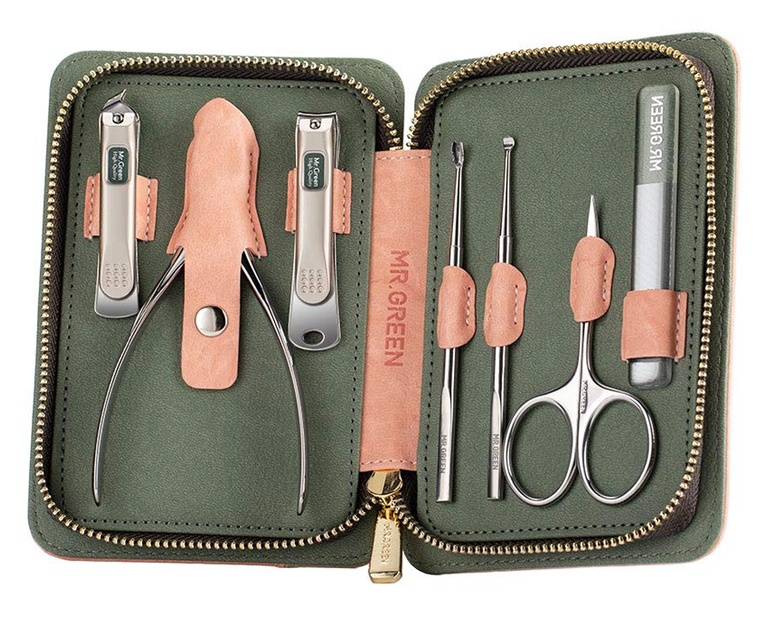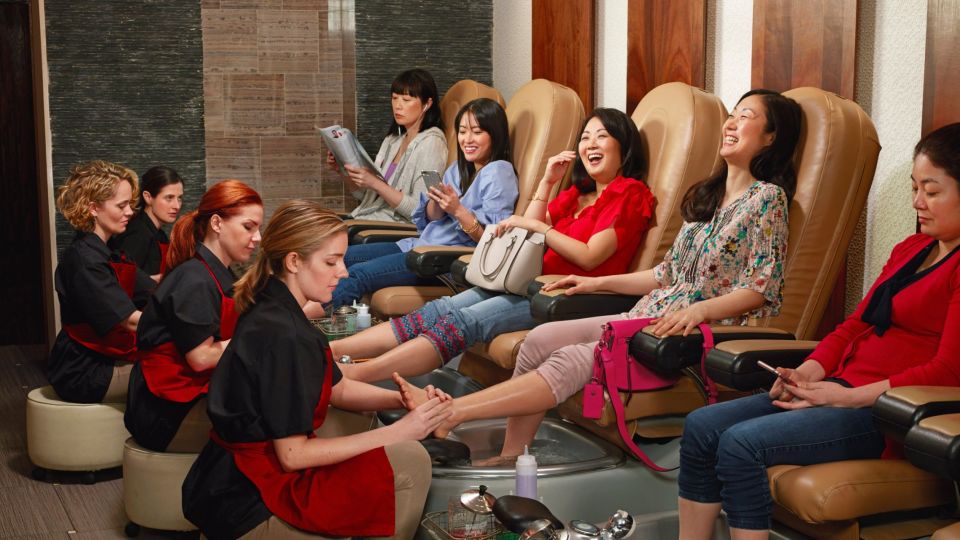The idea behind this post was originally to examine the health impacts of wearing nail polish, much like the sunscreen post I wrote a few weeks ago.[1] There are concerns about whether we inhale chemicals from the polish during application or through our nails once it’s applied, as well as whether the use of polish damages our nails (leading to continued use of polish to cover the damage). However, once I began to look for answers to those questions, I learned more about the service economy that has developed around nail polish, and I was horrified to learn the extent of public health concerns at play, representing a much greater problem than I ever imagined.
Physical Health
The answer to my original question is, unsurprisingly, less than straightforward. There are a range of different options for nail polish these days, and some appear to be worse than others. Traditional nail polish has been shown to interfere with measurements on pulse oximeters (the oxygen monitor that goes on your finger), indicating that it does create an oxygen barrier,[2] but nails get the nutrients and oxygen they need from the bloodstream, not the ambient air, so “depriving your nails of oxygen” isn’t really the issue. What does happen is that the polish acts as a moisture and vapor barrier, locking in moisture, which can reduce nail health and strength.
There are permeable or “breathable” nail polishes, which lead to stronger nails and longer-lasting manicures,[3] but I couldn’t find any evidence that the term is regulated, so it still makes sense to do your homework rather than trusting a claim on a label. In any case, dermatologists do recommend taking intermittent breaks from nail polish and not wearing it all the time,[4] though that can be easier said than done if your polish has discolored or damaged your nails. Furthermore, there are things your nails can tell your dermatologist about your health – but not if your nails are covered in polish.

Another common concern is the presence of toxins that help the nail polish do what it’s supposed to do. Some of the most harmful components frequently include:
- Dibutyl phthalate – used to make nail polish pliable, but it is a reproductive toxicant that can harm the fetus and impair fertility. It is banned in the EU but not in the US.
- Toluene – a solvent that helps smooth application of nail polish, but it is a volatile organic compound that can impair cognitive and kidney functions and impact fetal development.
- Formaldehyde – used to harden nail polish (and embalm corpses). It is a human carcinogen and has been banned from cosmetics in the EU.
Some “non-toxic” nail polishes label themselves as “three-free” (referring to the three chemicals above), “five-free,” “seven-free,” or “ten-free,” making reference to common sets of chemicals including phthalates, resins, parabens, camphor, xylene, and benzophenone. Studies have shown that chemicals in nail polish can be absorbed into the body, but it is unclear at the moment how much exposure causes harm. Unfortunately, it appears that even after some brands claimed to have removed such concerning chemicals from their formulations, random testing by government agencies showed that the chemicals were still there.[6]
Public Health
In addition to concerns regarding the chemicals in the nail polish, I’ve learned more than I wanted to about the mani-pedi process itself and the risks it poses for nail health. Yale dermatologists caution about the various opportunities that exist to pick up a fungal infection, namely when nails are getting wet, cut, or filed, or when cuticles are being pushed back or trimmed. Any of these instances provides an opportunity for bacteria and fungi to get under the nail. Salons are supposed to comply to stringent health regulations, but there isn’t really a way to tell except checking online reviews, looking for a Better Business Bureau accreditation, or asking to see the salon’s license while you’re there.

The same set of recommendations also mentions bringing your own set of mani-pedi tools with you to your appointment and making sure to clean them with warm, soapy water, dry them, and sterilize them with rubbing alcohol every time you use them. They recommend you do not let the nail technician cut or even push back your cuticles because that limits the cuticle’s ability to protect your nail and can cause permanent damage.[8]
Certainly, if your skin breaks while your cuticles are being trimmed, that is another opportunity for the spread of more serious diseases, but the truth is that fungal infections and skin disease are a frequent occupational hazard for nail salon workers because of the sheer volume of customers they see every day. As dangerous as it is for a customer who gets a weekly manicure (some people do), it can be 150 times more dangerous for a technician who sees as many as 30 customers a day (some of them do), and the increased risk for salon workers is something to keep in mind, whether we’re talking about the spread of disease or exposure to chemicals.
Social Equity
For people who work in this industry, spending all day, every day in salons, frequently diagnosed diseases include skin disorders and discoloration, cancer, gestational diabetes and miscarriage, asthma and lung scarring from acrylic dust, and more. The Occupational Safety and Health Administration (OSHA) is tasked with ensuring “safe and healthful working conditions for workers by setting and enforcing standards…”[9] Unfortunately, while there are chemical exposure levels in place for manicurists, the exposure levels are still set too high to prevent some of these adverse health outcomes, according to some advocates. Some individual states, such as California, have enacted more stringent safety requirements, but protections on the federal level remain particularly lax.

The sad truth is that many of these workers come from low-income families, meaning they can’t afford to quit and look for a safer work environment. Additionally, many of them are ethnic minorities who do not have sufficient English language skills to look for other work or even to stand up for fair treatment if they are in an exploitative situation.[11] Advocacy groups, such as the California Healthy Nail Salon Collaborative,[12] likely have far more sway than workers when it comes to supporting worker rights, but so do you.
Several years ago, Vox assembled a list of warning signs that could indicate worker exploitation or trafficking at a salon. Exploitation usually takes the form of low wages or illegal pay, and it could show up as a communal tip jar that is collected by someone other than the workers. Trafficking is when workers are being forced to stay in that job, and it could look like all of the workers leaving together at the end of the day and being transported by a third party. To be sure that your nail salon is treating their workers fairly, you can ask questions about how much they make and where they live – if there isn’t a language barrier.[13]
~
In next week’s conclusion, we’ll cover product options and best practices if you want to do your own mani-pedi at home. Spoiler alert: if I can do it, so can you.
Thanks for reading!
[1] https://radicalmoderate.online/sunscreen-risks-and-rewards/
[2] https://pubmed.ncbi.nlm.nih.gov/3382042/
[3] https://www.byrdie.com/breathable-nail-polish-4844505
[4] https://www.health.harvard.edu/blog/a-look-at-the-effects-of-nail-polish-on-nail-health-and-safety-2019112118231
[5] https://www.medicalnewstoday.com/articles/nail-diseases-chart#common-nail-diseases
[6] https://www.nytimes.com/2015/05/11/nyregion/nail-salon-workers-in-nyc-face-hazardous-chemicals.html
[7] https://www.cosmopolitan.com/style-beauty/beauty/g35630968/best-manicure-sets/
[8] https://www.yalemedicine.org/news/what-to-know-before-heading-to-a-nail-salon
[9] https://www.osha.gov/aboutosha
[10] https://www.cnn.com/2017/05/19/us/race-photo-series-o-magazine-trnd/index.html
[11] https://www.nytimes.com/2015/05/11/nyregion/nail-salon-workers-in-nyc-face-hazardous-chemicals.html
[12] https://www.cahealthynailsalons.org/
[13] https://www.vox.com/2015/5/8/8573425/manicure-worker-pay
2 Comments
Ian · August 2, 2021 at 12:38 am
And here I thought the formaldehyde would help my nails stay fresher longer.
Alison · August 5, 2021 at 8:21 am
“Fresh” isn’t the word I would use. “Preserved,” maybe. 😀